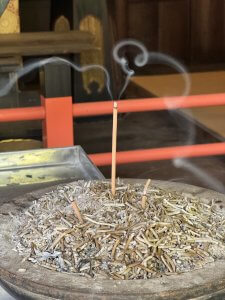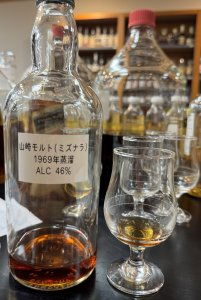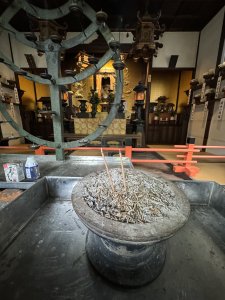The Smell of Temples

‘I have a very special whisky for you,’ says Yushi Noguchi. We’re in the blending lab at Yamazaki, every table littered with bottles. All are special, but as he manages the Suntory blending and R&D team, the fact he’s picked this one out clearly means something.
It’s red, so that’s a surprise. An aroma rises. It’s what I’ve been inhaling on the daily trips I’ve been making to the temple in Kyoto. The subtle smell of the lit incense stick drifting into the courtyard as I sit.
It’s the same aroma that came from the glass on that first day at Yamazaki, 22 years ago, when Seiichi Koshimizu had also said, ‘this is very special’ and then sat back, watching as Michael Jackson and I tried to get our heads around whatever it was. My first encounter with mizunara.
‘It smells of temples,’ he’d said, by way of explanation as we foundered around for descriptors. I believed him, of course I did, though as this was my first day in Japan and the itinerary hadn’t included a temple, what option did I have?
It’s only now that I remember that the day after they took me to a temple. No-one said, ‘breathe in’, just gave me the chance to learn. One of those silent, generous gestures of training and explanation.
Yushi’s one is from 1969. Is that even important? Yes, but not in a reductive sense of, ‘it’s old, it’s mizunara, therefore it must be expensive’. It is important because of what the aroma tells you. It is what tasting is about. Not descriptors, but what lies beneath. The why of the what.
The lesson here is about change. Of how a whisky is never fixed and that trying to pin it down – giving it a score or a medal – is pointless with something which is evanescent. Just allow it to proceed and come to you, and then see how a great whisky then changes you.

It is also about the changes that have produced that aroma and what memories it then triggers – the incense house we went to on the Giant Panda Happy Train through the back streets of Osaka close enough to touch the windows of the houses. That first day with Keiichi, his arms folded, grinning his shy smile, shoulders shaking with silent laughter as we fumbled around in our lexicon of aromas, trying to figure out just what the hell this thing was.
You can try to break it down scientifically as Yushi has, but mizunara isn’t a wood which behaves normally. His PhD research started with the aim of finding the source of the temple smell, but even he failed.
He did discover though that the coconut aroma which dominates in mizunara’s early years is, uniquely driven by the trans-lactone which is normally five times less potent than the cis-lactone were coconut usually resides (I paraphrase). More importantly, he proved that there is a synergy between the two. It’s important work.
The temple smell though? ‘We don’t know,’ he shrugs. ‘It’s still a mystery.’
The strangeness of mizunara, its complexities locked in, evolving in the tree over 200 years, waiting for felling, seasoning, toasting and then the slow ingress into spirit. Where does it start? In the acorn, the soil, the tree, the coopering?
Even when the cask is filled, mizunara’s temple remains hidden for another 18 or 20 years. Does it emerge quicker in refill, I ask. ‘No, it takes the same time,’ he replies. Smiles. ‘It’s mizunara.’
I wonder what the team makes of the various attempts of whisky makers around the world to give the ‘mizunara effect’ to their whiskies with six months of finishing. They’re too polite to answer. The only effect is the use of a name to justify a price hike.

It’s still there in the glass. It bites, almost snarls. It’s powerful, floral/herbal with the bitterness you want in a Manhattan. It seems smoky – maybe the incense coming through. The picture in my mind is one that pops up occasionally: a walk through an old growth forest – the tuff and leaf litter, petrichor, tree sap and resin. It’s the opposite of the graceful modest Japanese character we’ve come to expect.
It remains elusive. Maybe that’s right. Whisky isn’t there to be impaled like some butterfly. It only exists here, in this moment, filled with memories and ideas, changing and drifting in the air.